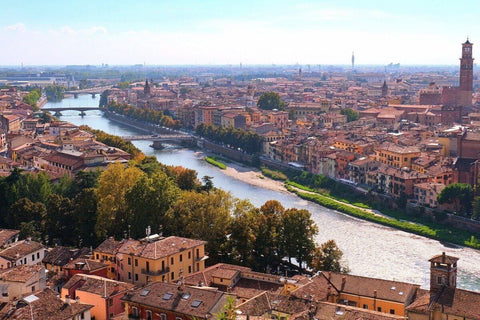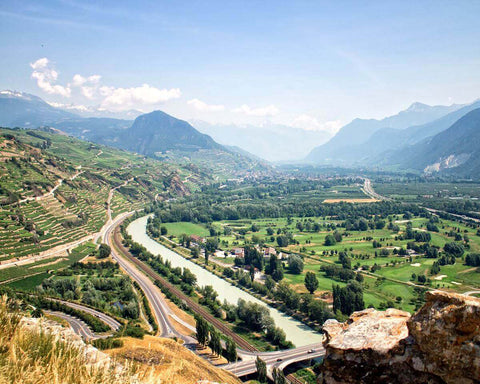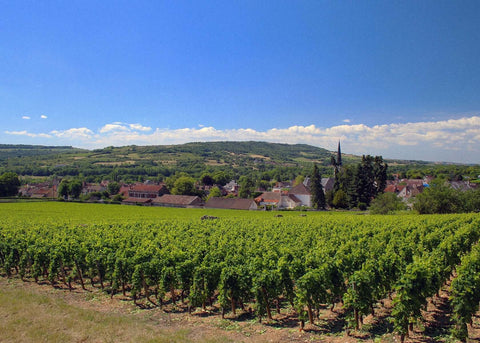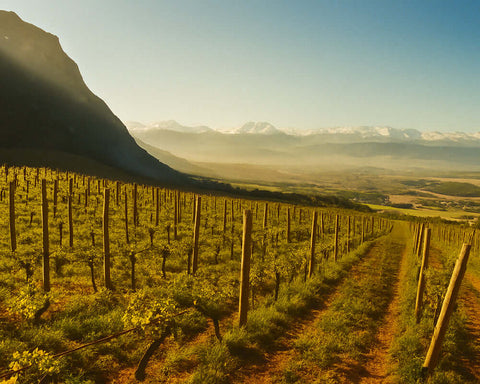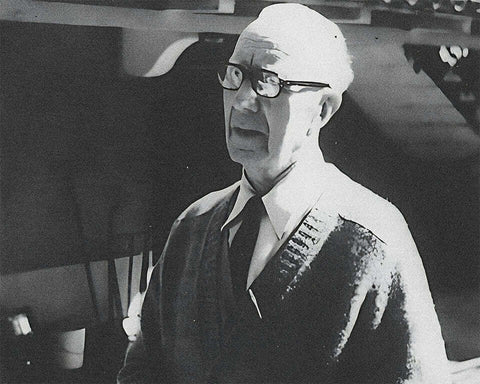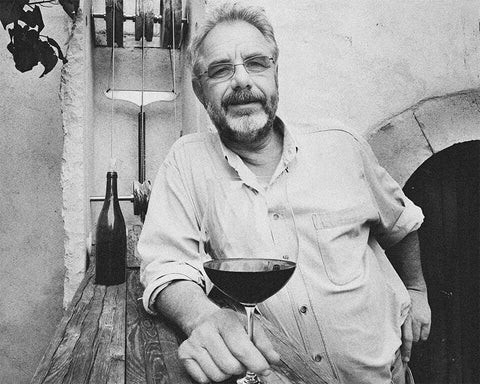Positioned in the northeastern quadrant of Italy, Veneto holds an esteemed place in the viticultural heritage of the nation. The region's historical depth, coupled with its diverse terrains, has always been conducive to viticulture.
In recent times, Veneto has emerged as a pivotal player in the arena of organic and natural wines. The adoption of modern sustainable practices positions Veneto as a leading force in the natural wine sector.
Here, the wines are a genuine reflection of the land, embodying the essence of the region's unique terroir and its commitment to environmental integrity.
Table of Contents
History
Spanning across the northeastern part of Italy, Veneto is bordered by Trentino-Alto Adige to the north, Friuli-Venezia Giulia to the northeast, Emilia-Romagna to the south, and Lombardy to the west. The region's verdant rolling hills serve as a backdrop to its rich tapestry of architecture, gastronomy, history, and wine. This diverse landscape has played a crucial role in shaping Veneto's viticultural history.
Ancient Roots
Viticulture in Veneto has ancient roots, dating back to pre-Roman times. The Euganei, Veneti, and Rhaetian peoples were cultivating grapes as early as 1300 BCE. Archaeological evidence suggests that wine was being produced in the Valpolicella area during the Bronze Age.
Roman Era
Veneto was under Roman dominion until the 5th century AD. The Romans significantly expanded viticulture in the region. They introduced new grape varieties and improved cultivation techniques. Pliny the Elder mentioned wines from the Valpolicella area in his writings, praising their quality. The Romans also developed an early version of the pergola training system, still used in parts of Veneto today.
Medieval Period and Venetian Republic
Following the fall of the Roman Empire, Veneto flourished as part of the illustrious Republic of Venice, "La Serenissima," until 1797. During this period, viticulture and wine trade became increasingly important to the region's economy. The Venetian Republic's extensive maritime trade network facilitated the export of Veneto wines throughout Europe and beyond.
Monasteries played a crucial role in maintaining and developing viticulture during the Middle Ages. The Soave and Valpolicella regions, in particular, saw significant development during this time. The technique of using partially dried grapes to make Recioto wines was refined during this period, eventually leading to the creation of Amarone.
Austrian Rule and Italian Unification
After the fall of the Venetian Republic, Veneto was under the Austrian Empire's sway before joining the Kingdom of Italy in 1866. The Austrian period saw further improvements in viticulture, with the introduction of new grape varieties and winemaking techniques.
The phylloxera crisis of the late 19th century devastated vineyards across Europe, including Veneto, leading to the replanting of many vineyards and changes in grape varieties. After joining the Kingdom of Italy, Veneto's wine industry began to modernize and expand.
20th Century and Modern Era
The 20th century saw significant developments in Veneto's wine industry. The establishment of the DOC system in 1963 helped to codify and protect traditional wine production methods and regions. Soave became one of Italy's first DOC wines in 1968, followed by Valpolicella and Bardolino.
The rise of Prosecco in the latter half of the 20th century transformed the region's wine landscape, with the Conegliano Valdobbiadene area becoming a major center of production. The creation of Amarone as a dry style of wine in the 1950s led to its rise as one of Italy's most prestigious wines.
Cultural Heritage
The region's capital, Venice, stands as an epitome of global cultural heritage, having been the epicenter of a prosperous maritime empire. Venice has also been the birthplace of luminaries like Giacomo Casanova, Marco Polo, and Antonio Vivaldi. This rich cultural heritage has influenced the region's wine culture:
The Venetian tradition of "bacari" (wine bars) serving "ombra" (small glasses of wine) with "cicchetti" (small snacks) continues to this day, showcasing local wines. The region's artistic and architectural wealth has helped to promote wine tourism, linking cultural and oenological experiences.
Recent Developments
In recent decades, Veneto's wine industry has continued to evolve:
There's been a renewed focus on indigenous grape varieties and traditional winemaking methods. The natural wine movement has gained traction, with many producers adopting organic and biodynamic practices. Climate change is posing new challenges and opportunities, leading to experimentation with different grape varieties and cultivation techniques. Veneto has become Italy's largest producer of DOC wines by volume, reflecting both the quantity and quality of its wine production.
Veneto's Terroir
Veneto's expanse is relatively smaller than some of Italy's other principal wine-producing regions, but it consistently tops the wine output charts. The region's terroir is notably diverse, offering a plethora of microclimates suitable for various grape varietals. This diversity is crucial in Veneto's ability to produce a wide range of wine styles, from light, crisp whites to full-bodied, complex reds.
Veneto is geographically segmented into distinct areas with unique climatic conditions and soil profiles. This variety in terroir contributes significantly to the region's rich viticultural landscape.
Northwestern Veneto: Valpolicella and Lake Garda
Climate:
The northwestern section of Veneto, enveloped by the Alps' foothills and Lake Garda's eastern periphery, hosts the famed Valpolicella, renowned for its red wines. This area benefits from a unique microclimate:
- Lake Garda moderates, creating milder winters and cooler summers.
- The Alps protect the region from cold northern winds.
- Warm air currents from the lake create excellent conditions for grape ripening.
- Diurnal temperature variations (warm days, cool nights) help develop complex grape flavors.
Soil Composition:
The soils in this area are diverse, contributing to the complexity of Valpolicella wines:
- Limestone and basalt base in many areas
- Clay-calcareous soils in the eastern part
- Alluvial soils with gravel and stones in the Classico zone
- These varied soils contribute to the wines' structure, minerality, and aromatic complexity.
Eastern Veneto: Soave and Prosecco Regions
Climate:
The eastern part of Veneto, home to the Soave and Prosecco regions, has a more continental climate:
- Warm summers and cold winters
- Significant diurnal temperature variations, particularly in the hillside areas
- The Adriatic Sea provides some moderating influence in coastal areas
Soil Composition:
- Soave (known for its volcanic soils, particularly in the Classico zone):
- Basaltic lava and volcanic tuff
- These soils impart distinct mineral characteristics to the Garganega-based wines
- Prosecco (Conegliano Valdobbiadene):
- Morainic hills with a mix of clay, limestone, and marine sandstone
- These well-draining soils, combined with hillside locations, are ideal for Glera cultivation
Central Veneto: Colli Euganei and Colli Berici
Climate:
The central hills of Veneto have a more pronounced continental climate:
- Hot summers and cold winters
- Hills provide varied exposures and altitudes, creating numerous microclimates
Soil Composition:
- Colli Euganei:
- Volcanic in origin with:
- Basalt and trachyte rocks
- Clay and limestone in some areas
- Colli Berici:
- Limestone-based soils
- Red clay rich in iron oxides in some parts
These diverse soils support a variety of both indigenous and international grape varieties.
Piave Area: Eastern Plains
Climate:
The Piave area in the eastern plains has a climate influenced by the Adriatic Sea:
- Warm summers with cooling sea breezes
- Mild winters
- Good ventilation, reducing the risk of fungal diseases
Soil Composition:
- Alluvial soils deposited by the Piave River
- Mix of gravel, sand, and clay
- Well-draining soils suitable for various grape varieties, including the native Raboso
Viticulture and Terroir Management
Veneto's vineyards span over 90,000 hectares, with 35,400 hectares designated DOC. This vast area encompasses various terroirs, each suited to different grape varieties and wine styles.
Over the past two decades, the region has witnessed an upsurge in the natural wine scene, further cementing its stature in the global wine community. This movement has led to an increased focus on terroir expression:
- Many producers are adopting organic and biodynamic practices to express their unique terroirs better.
- There's a growing emphasis on indigenous varieties well-adapted to local conditions.
- Winemakers increasingly use minimal intervention techniques to allow the terroir to shine through in the wines.
The Diverse Grape Varieties and Wines of Veneto
Veneto's rich viticultural landscape is home to a wide array of indigenous and international grape varieties, which contribute to the region's diverse wine portfolio. Veneto's unique terroir and climate allow for the cultivation of numerous grape varieties, each expressing distinct characteristics in the wines they produce.
Red Wines of Veneto
The region's red wines are primarily crafted from grape varieties such as Rondinella, Negrara, Cabernet Sauvignon, Corvina, Merlot, Pinot Nero, Molinara, and Raboso. However, the indigenous varieties play a particularly crucial role in defining Veneto's red wine identity.
Corvina
Corvina is the principal grape variety in many of Veneto's most famous red wines. It's known for its thick skin and high acidity, contributing to the structure and aging potential of the wines. Corvina is the backbone of:
- Amarone della Valpolicella DOCG: A full-bodied, high-alcohol wine from partially dried grapes. It offers complex flavors of ripe dark fruits, chocolate, and spices.
- Valpolicella DOC: A lighter, fresher red wine with notes of cherry and herbs.
- Valpolicella Ripasso DOC: A wine made by refermenting Valpolicella on the lees of Amarone, resulting in a wine with more body and complexity than regular Valpolicella.
- Recioto della Valpolicella DOCG: A sweet red wine made from dried grapes with rich flavors of ripe berries and chocolate.
Rondinella
Rondinella is often blended with Corvina in the wines of Valpolicella. It's valued for its resistance to disease and ability to withstand the drying process used in Amarone production. Rondinella contributes to the color stability and fruity aromas of these wines.
Molinara
Although its use has decreased recently, Molinara is still found in some traditional Valpolicella blends. It adds acidity and floral notes to the wines.
Oseleta
This ancient variety has been rediscovered and is gaining popularity, particularly in Amarone blends. Characterized by its small berry size, Oseleta contributes deep color, tannins, and structure to the wines, enhancing their aging potential.
Raboso
Indigenous to the Piave area, Raboso produces tannic, acidic wines with dark berries and spices flavors. It's used to produce Raboso Piave DOC wines.
White Wines of Veneto
Veneto's white wines showcase a blend of indigenous and international varieties, each contributing to the region's diverse white wine portfolio.
Garganega
This is the principal grape variety in Soave wines. Garganega thrives in the volcanic soils of the Soave region, producing dry white wines with:
- Flavors: Citrus, peach, honeysuckle, and almond
- Key Denominations:
- Soave DOC: Fresh, light-bodied wines
- Soave Classico DOC: More complex wines from the historic production zone
- Soave Superiore DOCG: Fuller-bodied wines with more concentration and aging potential
- Recioto di Soave DOCG: A sweet wine made from dried Garganega grapes
Glera (Prosecco)
Glera, formerly known as Prosecco, is the grape behind Veneto's famous sparkling wine. It's predominantly cultivated near Treviso in the Conegliano and Valdobbiadene areas. Prosecco wines are known for their:
- Flavors: Green apple, pear, honeysuckle, and fresh bread
- Key Denominations:
- Prosecco DOC: The basic designation, covering a wide area
- Conegliano Valdobbiadene Prosecco Superiore DOCG: Higher quality wines from a more specific area
- Asolo Prosecco DOCG: Another high-quality designation from the Asolo area
Pinot Grigio
While not indigenous to Veneto, Pinot Grigio has found a second home in northeastern Italy and is one of the nation's principal wine exports. In Veneto, it produces:
- - Flavors: Lemon, green apple, white peach, and subtle mineral notes
- - Styles: Typically light-bodied, crisp, and refreshing wines, often labeled under the Delle Venezie DOC
Trebbiano di Soave
Often blended with Garganega in Soave wines, Trebbiano di Soave adds acidity and floral notes.
Chardonnay and Pinot Bianco
These international varieties are used in various white wine blends across Veneto and some of the region's sparkling wines.
Cuisine
With influences from the Adriatic Sea, Venetian gastronomy plays a pivotal role in shaping regional Italian cuisine. Unlike several Italian regions where pasta reigns supreme, Veneto's staples are polenta and rice. Local pasta varieties include bigoli, a thick spaghetti variant.
Veneto's proximity to the Adriatic lagoon and coastline ensures an abundance of seafood in its culinary repertoire, including mussels, clams, crabs, anchovies, bream, and sea bass. The region's gastronomy is further enriched by dishes influenced by Lake Garda to its west.
Veneto's Appellations
Veneto is one of the regions with highest number of denomination of origins. This is due to the great number of terroir and grape varietals in the region.
DOCGs (Denominazione di Origine Controllata e Garantita):
- Amarone della Valpolicella DOCG
- Asolo Prosecco DOCG
- Bagnoli Friularo / Friularo di Bagnoli DOCG
- Bardolino Superiore DOCG
- Colli di Conegliano DOCG
- Colli Euganei Fior d’Arancio / Fior d’Arancio Colli Euganei DOCG
- Conegliano Valdobbiadene Prosecco DOCG
- Lison DOCG
- Montello Rosso / Montello DOCG
- Piave Malanotte / Malanotte del Piave DOCG
- Recioto della Valpolicella DOCG
- Recioto di Gambellara DOCG
- Recioto di Soave DOCG
- Soave Superiore DOCG
DOCs (Denominazione di Origine Controllata):
- Arcole DOC
- Bagnoli di Sopra / Bagnoli DOC
- Bardolino DOC
- Breganze DOC
- Colli Berici DOC
- Colli Euganei DOC
- Corti Benedettine del Padovano DOC
- Custoza DOC
- Delle Venezie DOC
- Gambellara DOC
- Garda DOC
- Lessini Durello / Durello Lessini DOC
- Lison-Pramaggiore DOC
- Lugana DOC
- Merlara DOC
- Montello Asolo / Asolo Montello DOC
- Monti Lessini DOC
- Piave DOC
- Prosecco DOC
- Riviera del Brenta DOC
- San Martino della Battaglia DOC
- Soave DOC
- Valdadige / Etschtaler DOC
- Valdadige Terradeiforti / Terradeiforti DOC
- Valpolicella DOC
- Valpolicella Ripasso DOC
- Venezia DOC
- Vicenza DOC
- Vigneti della Serenissima / Serenissima DOC
